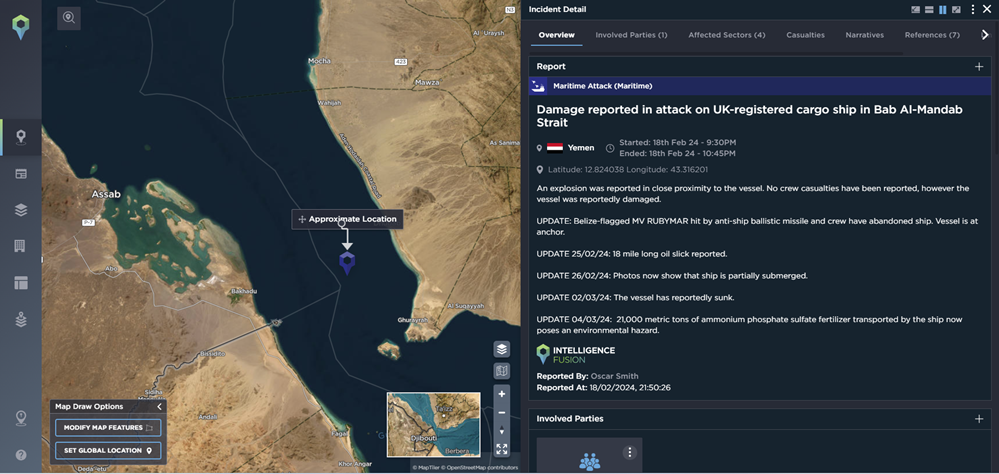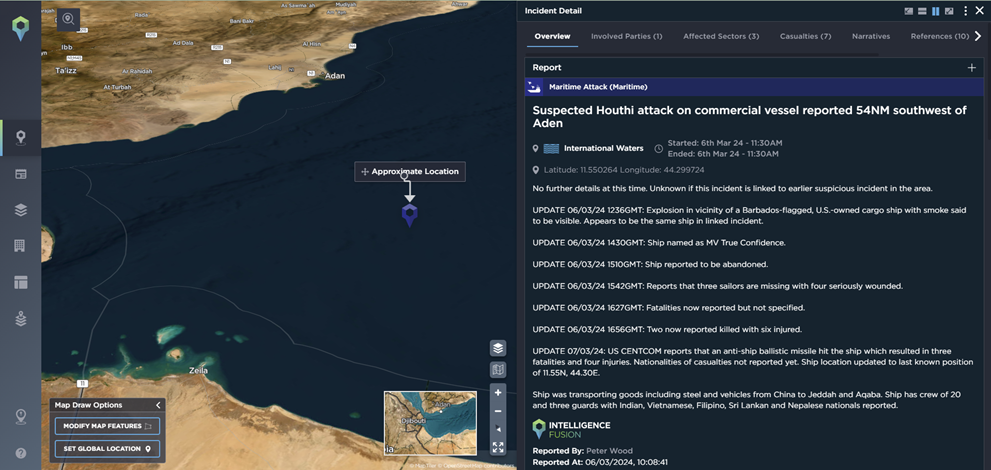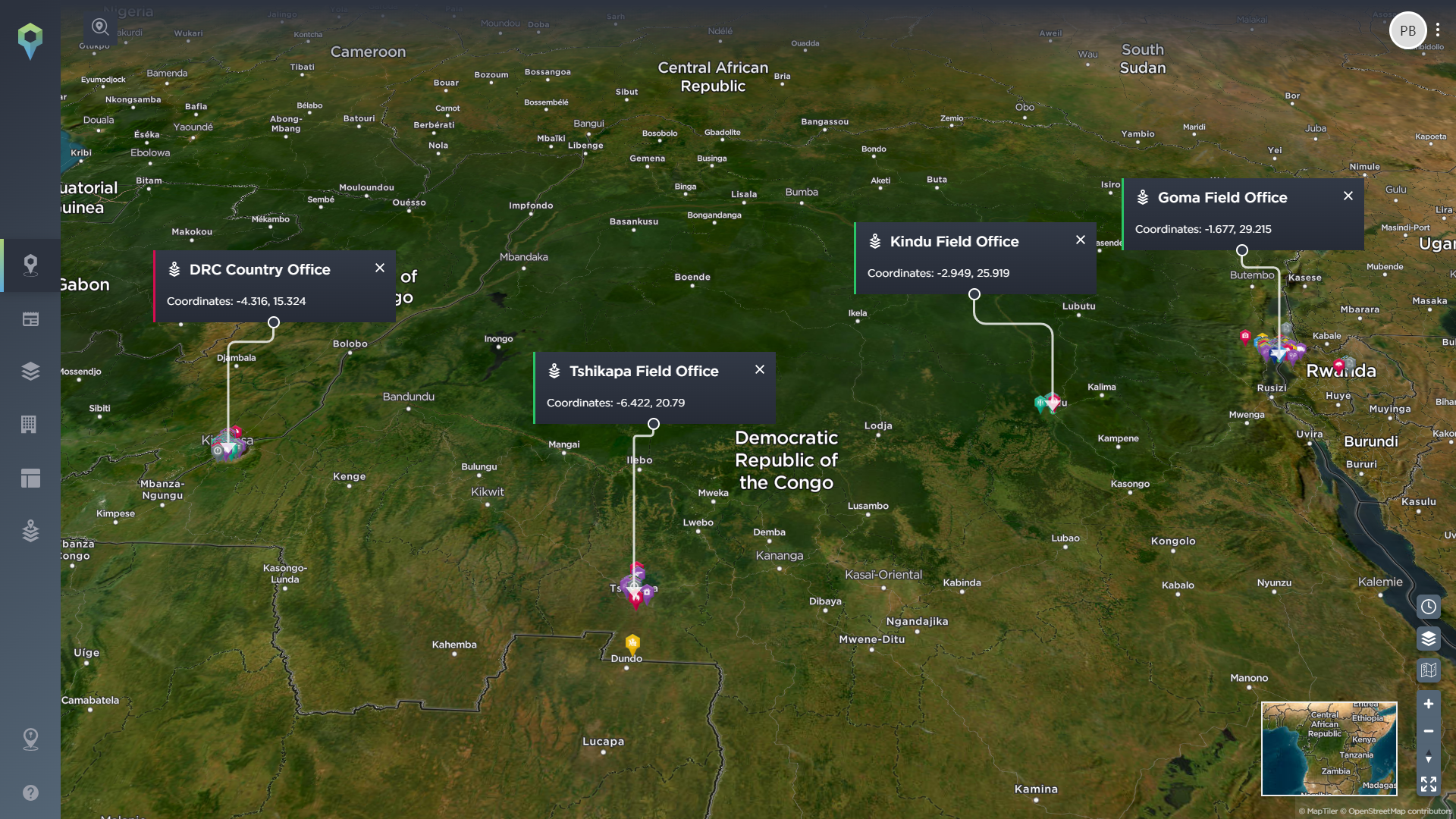Houthi attacks on shipping: How long could the Red Sea crisis last?
As Houthi attacks on shipping continue to impact global trade, how long might the Red Sea crisis continue? We analyse Houthi weapons and capabilities, the impact that US and UK airstrikes on Yemen have had on their attacks on shipping, and what the future of the Red Sea crisis might look like.
Following unsuccessful rocket attacks on southern Israel, Houthi forces in Yemen announced they would target Israeli and Western shipping in the Red Sea to support Hamas in its conflict with Israel. On the 19th of November 2023, the Houthis began targeting civilian shipping in the Red Sea and Gulf of Aden around the Bab al Mandeb strait.
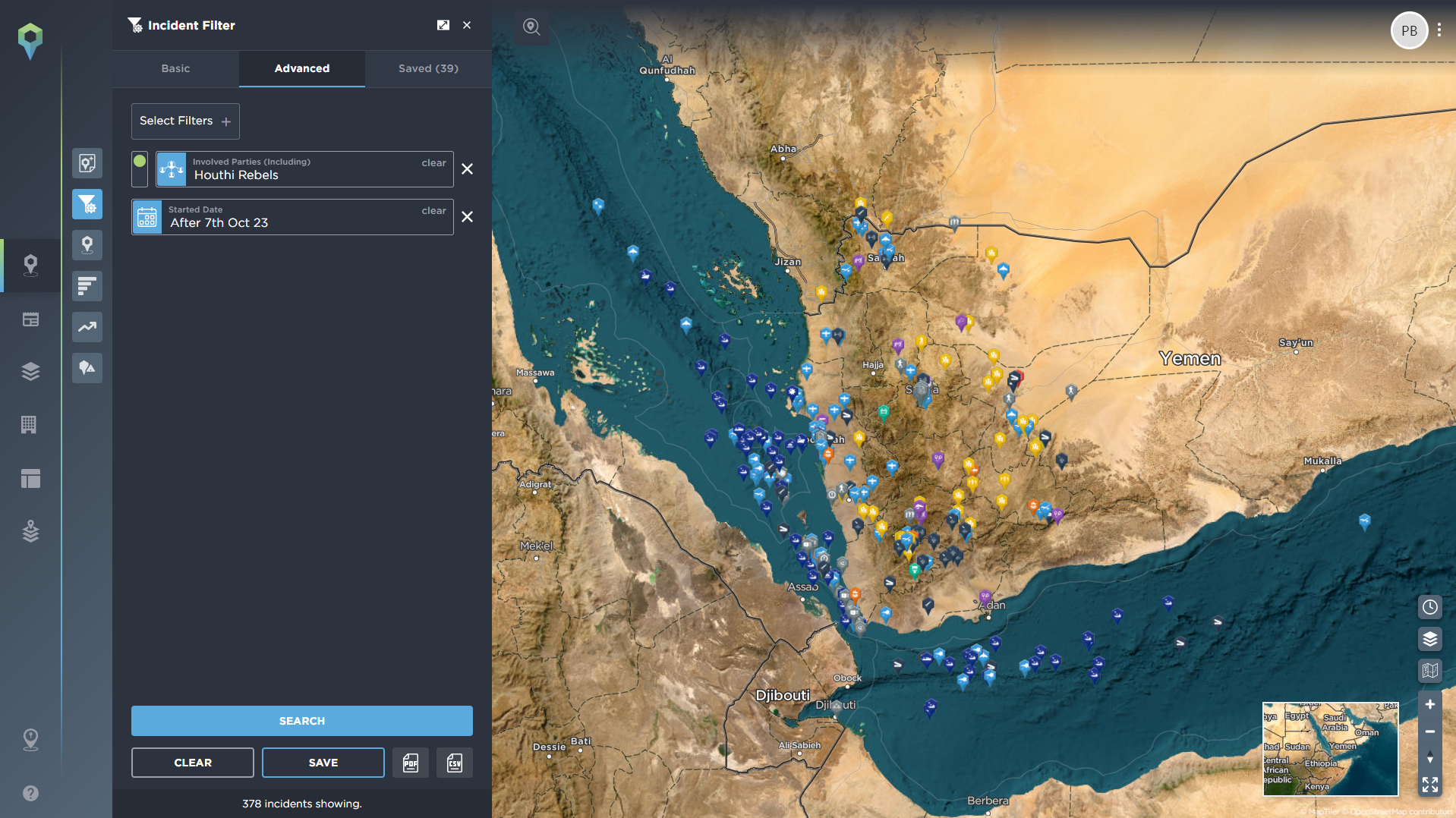
Incidents in and around the Bab al Mandeb Strait and the Red Sea [image source: Intelligence Fusion]
Numerous ships, both civilian and military, have been targeted with an array of weaponry. These attacks have led to the sinking of the MV Rubymar after being hit on the 19th of February 2024 and the fatalities after MV True Confidence was hit on the 6th of March. The cost of the attacks on shipping has been enormous as ships are now forced to transit around Africa via the Cape of Good Hope rather than use the Suez Canal. The route, which once carried 15% of global commerce, is down around 70% compared with the start of the attacks. As they are the most common targets, container shipping has dropped around 90%. Journey times are, on average, 30% longer, and freight rates have rocketed, leading to substantially increased transport costs.
The attack and subsequent sinking of the MV Rubymar; the attack on MV True Confidence that resulted in the first fatalities since the attacks on shipping began [images source: Intelligence Fusion]
Houthi weapons and capabilities
The Houthis possess considerable and varied capabilities, which makes countering attacks extremely difficult. The Houthis inherited a large Soviet-era missile arsenal from the previous Yemeni President, Ali Abdullah Saleh when he defected to them in the Yemeni Civil War. In addition, they have access to more advanced weaponry based on Iranian technology, like the Asef Anti-Ship Ballistic Missile with a 500 kg warhead and a 400 km range. They also utilise anti-ship cruise missiles (ASCMs) such as the Al-Mandeb 2, based on the Chinese C-802, which has a range of 120 km and a 165 kg warhead. The Houthis claim to have developed many of these weapons domestically, but the US disputes this, attributing their acquisition to Iranian support. It is likely that missile components have been smuggled in part from Iran via overland routes or small dhows common in the area. It is unclear if these smuggling efforts will be able to reinforce stockpiles with the pace of US and UK airstrikes.
Their missile arsenal also includes long-range cruise missiles such as the Iranian-designed Quds-3.
Given the range, the Quds 3 was likely used to target the Israeli city of Eilat on 19th March 2024. The missile hit an open area. Russian state media have claimed that Houthis possess a hypersonic missile, but the veracity of this is unknown. However, the number of total missiles in the Houthi arsenal is unknown due to significant intelligence gaps in US intelligence.
In addition to missiles, the Houthis employ UAVs like the Samad-2 and -3, capable of long-range travel and equipped for remote operation, potentially by satellite communication. These drones have also been used against shipping.
Having outlasted a sustained Saudi Arabian air campaign, the Houthis have experience in minimising damage to their missile launching capabilities, with them using underground missile launchers to fire ballistic missiles. However, while the Houthis demonstrate experience and adaptability, their maritime strike capabilities suffer from a lack of effective targeting infrastructure. Coastal radars previously used for coordination were destroyed by US and UK airstrikes. It has been speculated that the converted civilian ship, the MV Beshad, is an Iranian surveillance ship providing intel to the Houthis. The Beshad’s capabilities are limited to SIGINT and observation. It is believed that this, alongside UAVs and open-source AIS tracking, is being used to triangulate ships’ movements. In addition, IRGC commander Abdul Reza Shahlai is said to have directed the first Houthi attacks from inside Yemen and commanded their drone and missile forces.
Limitations and disruption to Houthi threat
Despite this, it appears that Houthi’s capabilities may have been disrupted by US and UK actions. It is reported that the Beshad was targeted in a cyber attack, which may have affected its potential to provide targeting information. It also appears that the Houthis have slowed down and shifted from attacks with cruise missiles to less dangerous drones, which is likely due to airstrikes on missile launch positions. It also appears that the Houthis have stopped using drones for high-level reconnaissance as they began to be shot down quite easily. Now, drones are fired at low altitudes across the water to avoid detection and attack ships directly. The successful impact on the Chinese-operated crude oil tanker Huang Pu on the 23rd of March 2024 may be evidence of the degradation of Houthi targeting activities. Chinese and Russian ships have been given safe passage by Houthi forces.
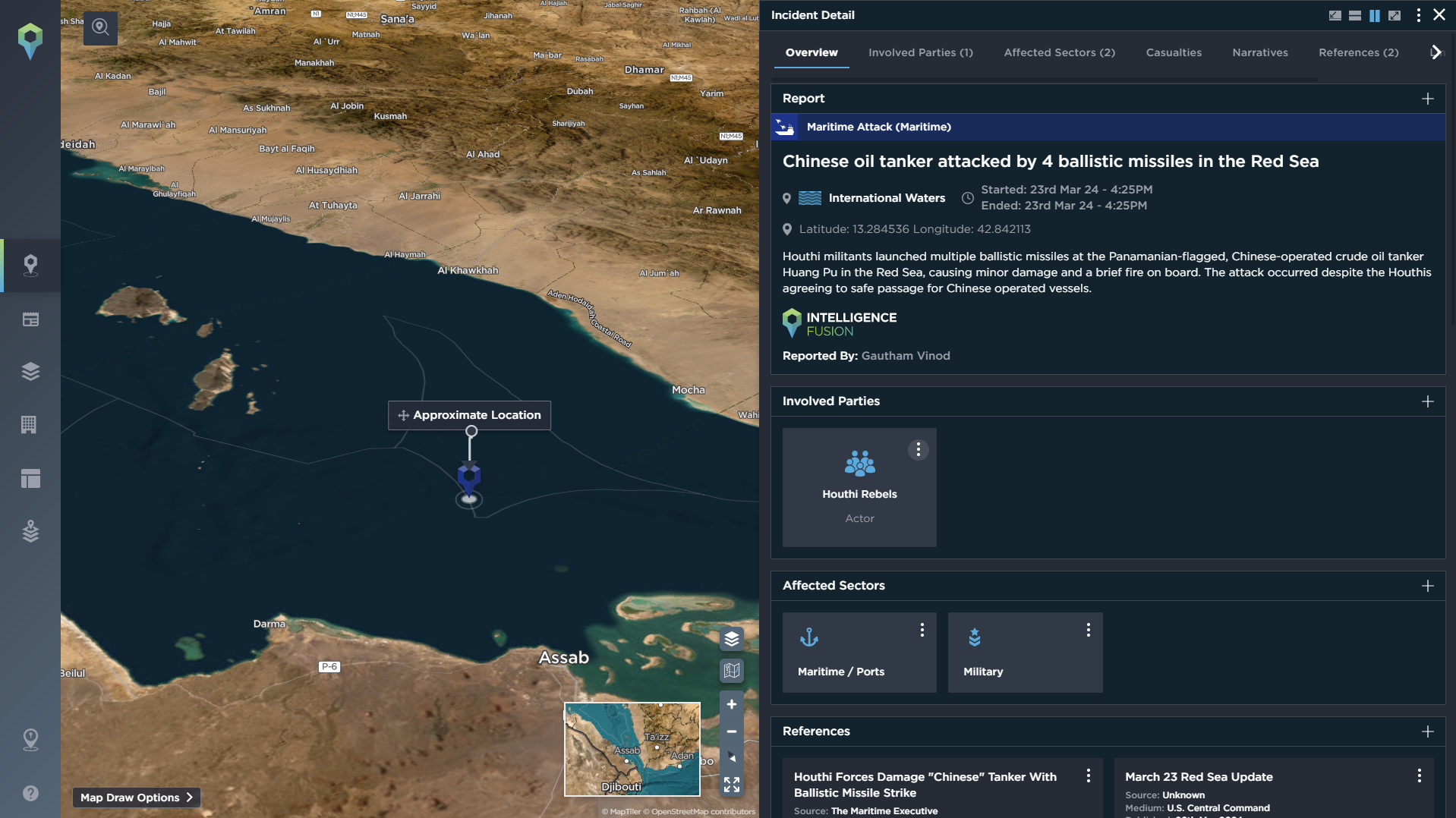
A Chinese oil-tanker was attacked on 23rd March 2024, despite the Houthis agreeing to safe passage for Chinese operated vessels [image source: Intelligence Fusion]
While targeting commercial vessels is still feasible with their current capabilities, western warships pose a greater challenge due to their evasive actions and countermeasures. The accuracy of Houthi anti-ship ballistic missiles (ASBMs) against moving targets is questionable, possibly due to the absence of maneuverable re-entry vehicles (MARVs) necessary for accuracy, which are difficult to design and transport.
The future of the Red Sea crisis
The military response to Houthi attacks has had some impact and is symbolically significant for Western nations. However, its limited overall impact could potentially exacerbate the situation. It may prompt the Houthis to intensify their maritime attacks and target a broader range of vessels in a more indiscriminate manner. If it appears that nearby states have allowed the use of their airspace for US and UK aircraft to conduct airstrikes, we will likely see Houthi attacks on energy infrastructure in Saudi Arabia and the UAE.
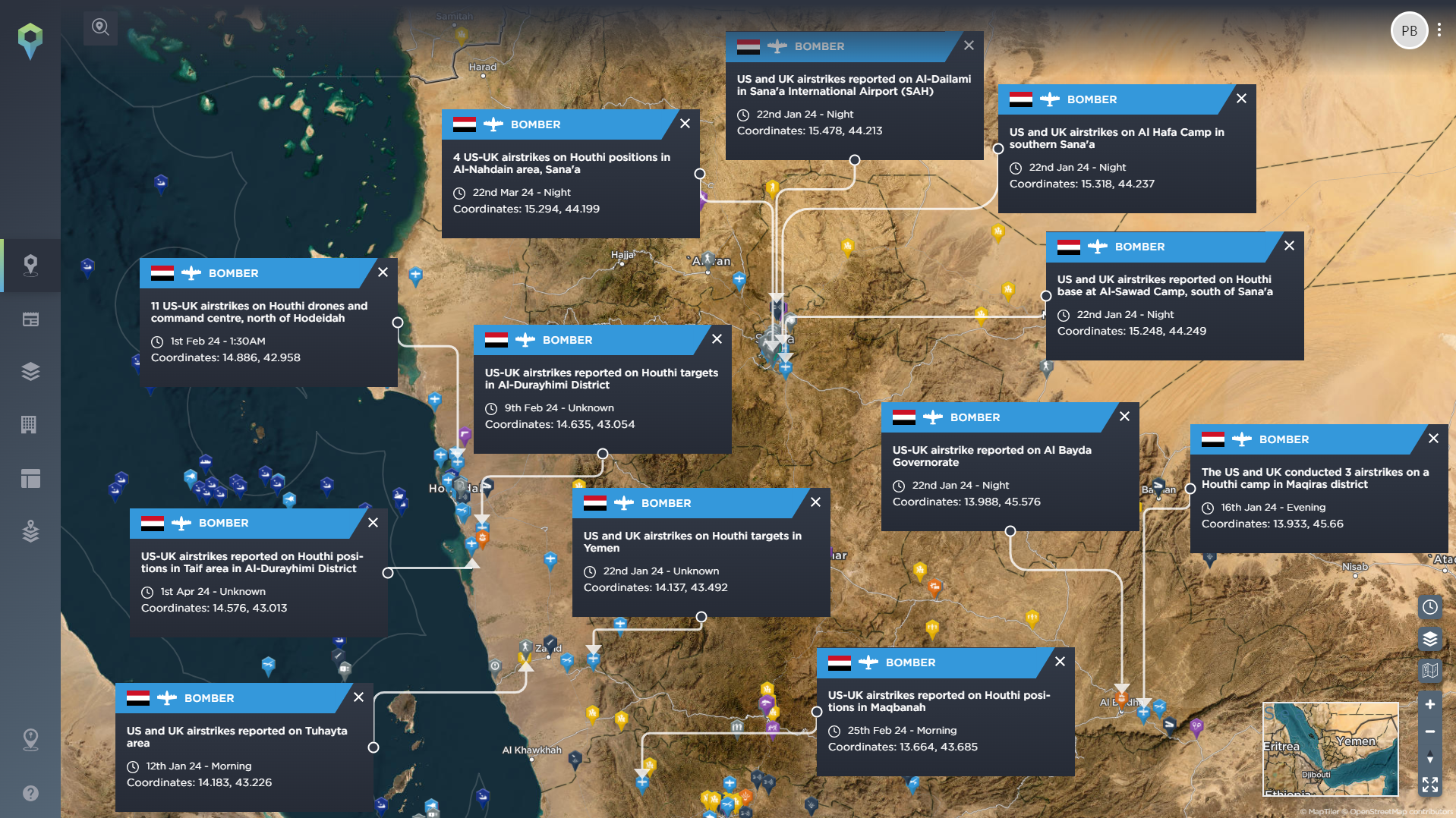
US and UK airstrikes on Houthi locations [image source: Intelligence Fusion]
Recently, the Houthi leader, Abdul Malik al-Houthi, has announced they will target Israeli-linked vessels through the Indian Ocean towards the Cape of Good Hope. As previously noted, this naval targeting may prove much more difficult given the distance involved and lack of coastal radar. However, given the presence of Somalian criminal groups in Yemen, it is possible that Houthi could outsource to Somalian groups to aid in target shipping in the Horn of Africa. This could involve targeting coordination in a rudimentary fashion akin to the MV Beshad or piracy attacks without direct Houthi involvement.
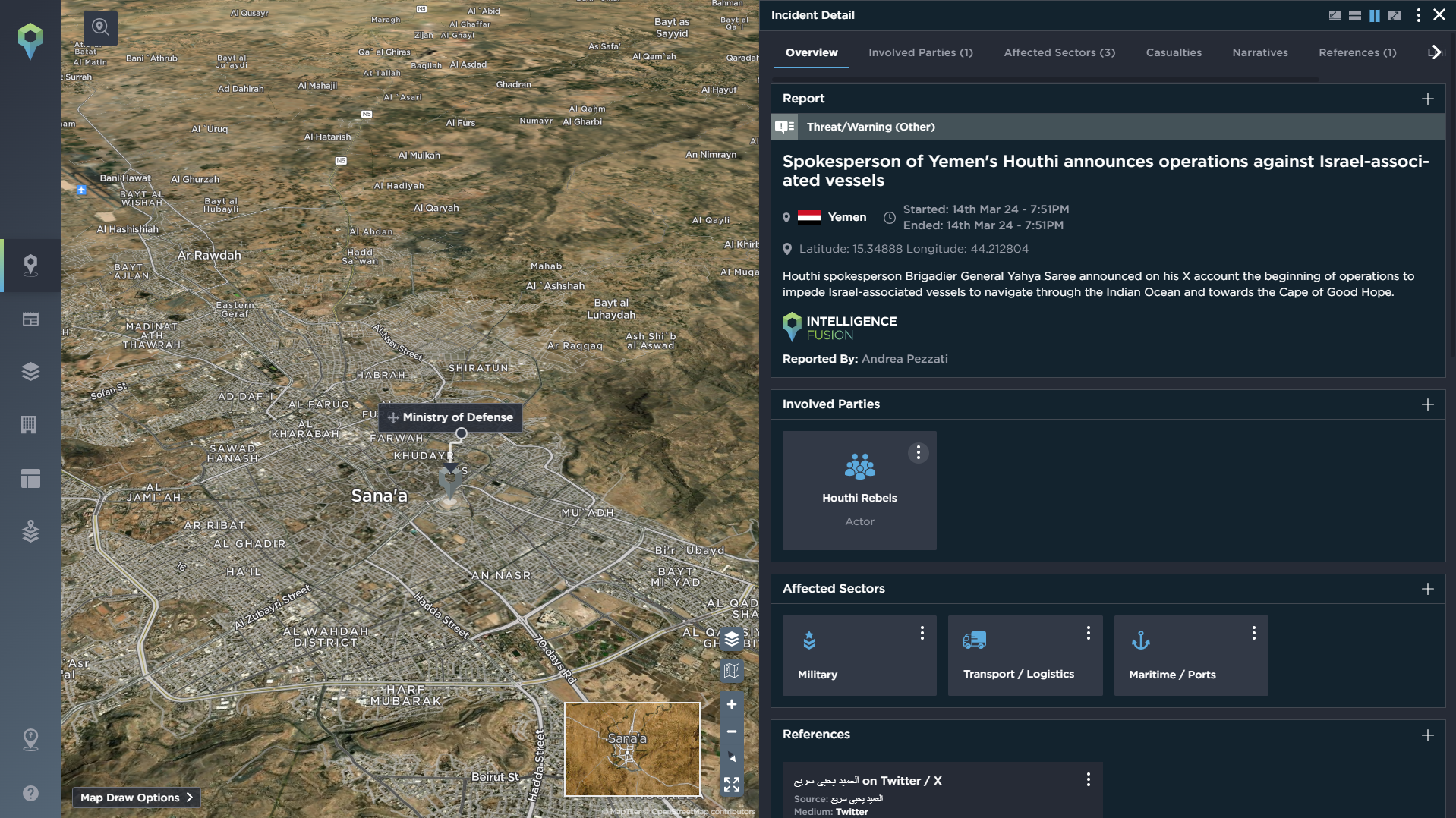
A Houthi spokesperson threatened shipping in the Indian Ocean in March 2024 [image source: Intelligence Fusion]
In the long term, from a domestic viewpoint, the US and UK airstrikes could strengthen the Houthis. The Saudi-led coalition’s 2015 attack on the Houthis in Yemen did not weaken them but instead strengthened their resolve. Current Houthi military actions may garner support from Yemenis sympathetic to the Palestinian cause, even if they oppose the group otherwise.
The Houthis may not be deterred by military strikes or delays in ceasefire negotiations with Saudi Arabia, feeling emboldened by popular support and willing to endure costs. However, de-escalation remains a remote possibility if the Gaza conflict ends, provided the situation in the Red Sea remains manageable. On the other hand, if Hamas is comprehensively defeated in Gaza and Israeli action against Hezbollah remains a strong possibility, then Houthi attacks will continue. It should also be noted that although Houthi attacks during the last ceasefire dropped, they still fired two ballistic missiles at the USS Mason in the Gulf of Aden.
With it unclear if the Houthis have been fully deterred by airstrikes and provenly capable and intent on damaging commercial shipping, the Red Sea crisis does not appear likely to subside in the near future. The threats issued against shipping in the Indian Ocean – while not as severe as the threat posed in the Bab al Mandeb Strait and Red Sea – could exacerbate and expand the crisis. A resurgence in Somali piracy adds another complexity to the issue.
This makes tracking, understanding, and planning for the threats to your organisation posed by the Red Sea crisis absolutely essential. Whether this is a direct threat posed to your shipping and maritime logistics operations, or the increased risk to and impact on your supply chains, using threat intelligence data to understand the ongoing and historical situation is a key tool for your company’s security and risk teams.
At Intelligence Fusion, not only have we been closely tracking the attacks on shipping and the ongoing situation since it began, our analysts also identified the potential for the Red Sea crisis to develop before the first Houthi attack, as part of our Emerging Threats feature.
If you’d like to learn more about our threat intelligence platform, and how we help organisations across the globe manage their security and risk, book some time to speak with a member of the team today.

